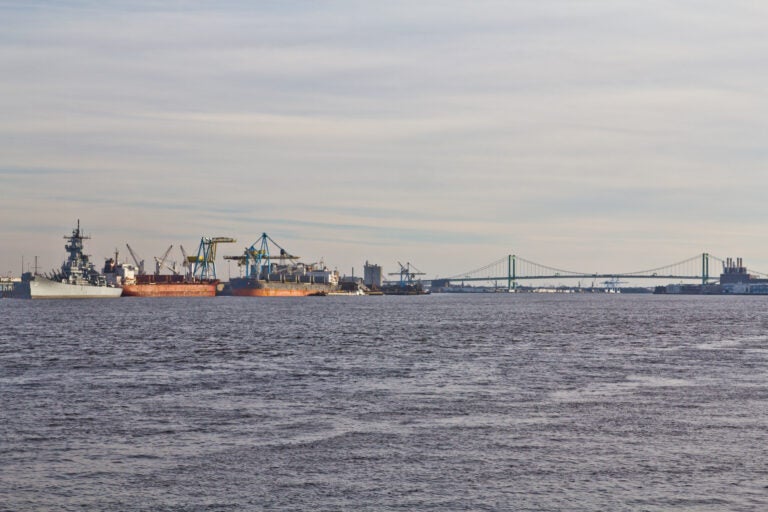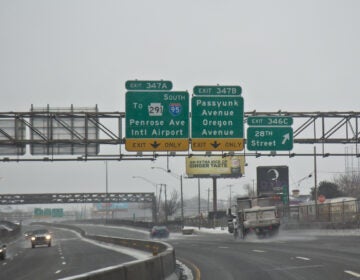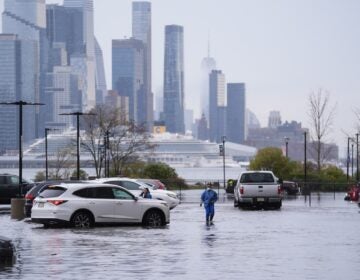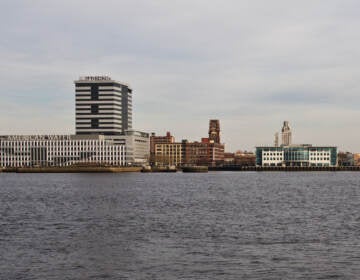‘An upward direction’ for the Delaware River: UPenn researchers recommend ways to make swimming safer
A 27-mile stretch of the Delaware River in the areas of Philadelphia and Camden is not safe for swimming. UPenn researchers evaluate how to improve water quality.

File photo: The Walt Whitman Bridge between Pennsylvania and New Jersey over the Delaware River. (Kimberly Paynter/WHYY)
This story is part of the WHYY News Climate Desk, bringing you news and solutions for our changing region.
From the Poconos to the Jersey Shore to the mouth of the Delaware Bay, what do you want to know about climate change? What would you like us to cover? Get in touch.
Many older cities, such as Philadelphia and Camden, struggle to meet the federal Clean Water Act requirements of having “swimmable” waterways because of outdated sewer systems.
The Delaware River often contains fecal bacteria levels that make it unsafe to swim, fish or even kayak. That’s because stormwater and sewage often flow through the same underground pipes. During heavy rain, the system can overflow, spilling sewage into the region’s rivers and streams.
Researchers at the University of Pennsylvania’s Water Center have evaluated fecal bacteria levels in the Philadelphia, Chester and Camden region of the Delaware River. The study found that costs to upgrade this older infrastructure are a significant barrier to achieving swimmable water, and offered recommendations to improve water quality in a cost-effective and timely manner.
“It’s important to know how far we’ve come, and how far we still need to go, to make the Delaware River fishable, swimmable and drinkable,” said Howard Neukrug, executive director of UPenn’s Water Center.
Prior to the federal Clean Water Act, the Delaware River between Trenton and Philadelphia supported virtually no life at all. More than 50 years ago, regulations changed what was once a “stinky, ugly mess” into a place where hundreds of thousands visit its urban shorelines each year. Treatment plants along the Delaware and Schuylkill rivers provide clean drinking water to about 15 million people. However, urban parts of the Delaware River and its tributaries, like the Schuylkill and Wissahickon, are still too polluted to swim in.
Swimming and kayaking is permitted in much of the Upper Delaware River, which is regulated by the Delaware River Basin Commission. However, for a 27-mile stretch along Philadelphia and Camden, the DRBC restricts residents to boating and fishing.
The UPenn study, which was done in collaboration with other academic institutions, nonprofits and regulatory agencies, found bacteria levels in the Delaware River varied across sites, and by month. Water quality conditions generally were worse during wetter months, and overall, the highest levels of fecal bacteria were found within 2,500 feet of a combined sewer outfall — large underground pipes that empty stormwater into streams like the Wissahickon, and rivers like the Schuylkill and Delaware.
The study found that fecal coliform levels are much higher along the shoreline than in the center channel. That’s partly because pollution gets caught along the edges, Neukrug said.
“Where you want to swim is also where the [bacteria] numbers are the highest,” he said.
More data is needed to determine where fecal bacteria comes from, where it’s going and how long it remains in the water, Neukrug said. Understanding these factors is challenging because the tide in the Delaware River shifts bacteria back and forth, he said.
Investing in stormwater infrastructure
State and federal regulations require cities to reduce 85% of stormwater and sewage overflow, and significant progress has been made, according to the report. The Camden County Municipal Utilities Authority, the Delaware County Water Quality Control Authority and the Philadelphia Water Department have set aside millions of dollars to make capital improvements to their sewer systems.
For instance, in 2011, PWD launched a 25-year plan, known as Green City, Clean Waters, to reduce the amount of sewage entering the city’s waterways by using green infrastructure and expanding stormwater treatment capacity. The department said it has reduced overflows by 3 billion gallons by utilizing technology composed of natural elements such as rain gardens to soak up stormwater.
PWD recently received $25 million in federal ARPA funds — the $1.9 trillion COVID relief bill President Biden signed nearly three years ago. PWD will use $15 million to fund a new pretreatment building at the Northeast Water Pollution Control Plant, which will reduce combined sewer overflows by an additional 600 million gallons annually in the next three years.
However, though federal funding is available through the Bipartisan Infrastructure Law, the report finds that there’s not enough dollars available to help municipalities pay the infrastructure costs. In the Delaware River alone, the cost to remediate the combined sewer overflow is estimated at about $2 billion, according to the report. On top of that, municipalities are grappling with how to finance efforts to eliminate dangerous PFAS chemicals from drinking water, and replace lead pipes.
Neukrug said it could take another 15 years for cities to achieve their goals of reducing sewage spills. However, once accomplished, there will be about a 50% reduction in fecal bacteria pollution, he said.
Marc Cammarata, deputy water commissioner for planning at PWD, said when the city completes its 25-year plan, there will be a remaining five-plus billion gallons of combined sewer overflow. The biggest hurdle to decreasing bacteria levels is attempting to reduce ratepayer impacts, he said.
“Projected estimates are in the range of $4 to $5 billion of investment to tackle this issue alone,” Cammarata said.
The city’s capital budget for water, wastewater and stormwater services over the next six years is almost $5 billion.
Cammarata said the city is excited that people are participating in activities such as boating along the Delaware River. However, he cautions that swimming in the Delaware River does pose risks, because of fast-moving currents through deep water, commercial shipping and debris.
“I want to continue these conversations about the benefits of achieving primary contact for recreation. But the cost in doing so, it may take decades for the city to achieve swimmable conditions,” Cammarata said. “These costs must absolutely be balanced with multiple evolving regulatory obligations — including replacing lead service lines, protecting our drinking water from emerging contaminants like PFAS, managing nutrients and improving dissolved oxygen in our water bodies from our treatment plans.”
The DRBC also said it’s working to develop a strategy to reduce bacteria levels and increase recreational opportunities. The agency’s plan includes continuing data collection, and identifying funding opportunities for infrastructure upgrades.
Prioritizing watersheds
The UPenn study identified six local sites that stakeholders could consider prioritizing for increased water recreation: Pyne Poynt Park, Chester Riverfront, Bartram’s Garden, John Heinz National Wildlife Refuge, River Fields, and Frankford Arsenal Boat Ramp.
The researchers found that water quality conditions at these sites are close to meeting safety standards during most days, are easily accessible and are close to communities that currently don’t have opportunities to participate in water activities.
The study determined that achieving swimmable waters in these areas could be cost-effective, fundable, and could realistically be achieved within a five-year period.
“We really need to prioritize key watersheds and sewersheds where improvements will improve the lives of the underserved residents by reducing basement flooding of sewage contaminated water, and/or access to cleaner, safer water for recreation,” said Drexel University’s Carol Collier, who partnered with UPenn on the research.
The researchers made several recommendations to improve water quality in the Delaware River in a cost-effective, timely manner. That includes advocating for more funding, accelerated investments in green stormwater infrastructure, and developing a community science monitoring network and using the data to better inform the public about bacteria levels.
The report finds there also are fast and low-cost strategies to address fecal bacteria pollution, such as netting that traps litter and sewer solids, and inlet filters that strain standard water particles and debris before fluid enters a pump.
Neukrug said it may be more feasible for stakeholders to prioritize tributaries for water recreation because they are more manageable and have a quicker return than the Delaware River itself.
“I think the general public … is hopefully going to start to understand how complicated this is, and how expensive this is,” Neukrug said, “And to be really happy about the changes that you can make now, and how things are improving in that everything is on an upward direction.”

Get daily updates from WHYY News!
WHYY is your source for fact-based, in-depth journalism and information. As a nonprofit organization, we rely on financial support from readers like you. Please give today.







